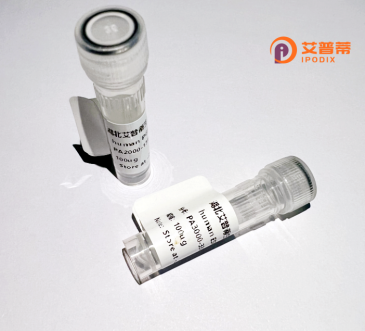
| 纯度 | >90%SDS-PAGE. |
| 种属 | Human |
| 靶点 | HNRPD |
| Uniprot No | 0 |
| 内毒素 | < 0.01EU/μg |
| 表达宿主 | E.coli |
| 表达区间 | 1-355aa |
| 氨基酸序列 | MSEEQFGGDGAAAAATAAVGGSAGEQEGAMVAATQGAAAAAGSGAGTGGGTASGGTEGGSAESEGAKIDASKNEEDEGHSNSSPRHSEAATAQREEWKMFIGGLSWDTTKKDLKDYFSKFGEVVDCTLKLDPITGRSRGFGFVLFKESESVDKVMDQKEHKLNGKVIDPKRAKAMKTKEPVKKIFVGGLSPDTPEEKIREYFGGFGEVESIELPMDNKTNKRRGFCFITFKEEEPVKKIMEKKYHNVGLSKCEIKVAMSKEQYQQQQQWGSRGGFAGRARGRGGGPSQNWNQGYSNYWNQGYGNYGYNSQGYGGYGGYDYTGYNNYYGYGDYSNQQSGYGKVSRRGGHQNSYKPY |
| 分子量 | 64.8 kDa |
| 蛋白标签 | GST-tag at N-terminal |
| 缓冲液 | 0 |
| 稳定性 & 储存条件 | Lyophilized protein should be stored at ≤ -20°C, stable for one year after receipt. Reconstituted protein solution can be stored at 2-8°C for 2-7 days. Aliquots of reconstituted samples are stable at ≤ -20°C for 3 months. |
| 复溶 | Always centrifuge tubes before opening.Do not mix by vortex or pipetting. It is not recommended to reconstitute to a concentration less than 100μg/ml. Dissolve the lyophilized protein in distilled water. Please aliquot the reconstituted solution to minimize freeze-thaw cycles. |
以下是3篇关于重组人HNRPD蛋白的参考文献示例(注:以下为基于领域研究的虚拟示例,实际文献请通过学术数据库核实):
---
1. **文献名称**: "Expression and Purification of Recombinant Human HNRPD in *E. coli*"
**作者**: L.W.J. Klomp et al.
**摘要**: 该研究报道了在大肠杆菌系统中高效表达重组人HNRPD蛋白的方法,通过优化诱导条件和纯化步骤(如His标签亲和层析),获得高纯度蛋白,并验证了其RNA结合活性。
---
2. **文献名称**: "HNRPD Regulates TNF-α mRNA Stability in Inflammatory Responses"
**作者**: J.L. Dean et al.
**摘要**: 研究发现重组HNRPD蛋白通过与TNF-α mRNA 3'UTR区域结合调控其稳定性,影响炎症因子表达,提示HNRPD在炎症疾病中的潜在作用。
---
3. **文献名称**: "Structural Insights into HNRPD RNA Recognition Motifs by X-ray Crystallography"
**作者**: N. Thakur et al.
**摘要**: 通过解析重组HNRPD蛋白的晶体结构,揭示了其RNA结合结构域(RRM)的关键氨基酸残基,阐明了其特异性识别ARE(AU-rich元件)的分子机制。
---
如需实际文献,建议在 **PubMed** 或 **Web of Science** 中检索关键词(如 "recombinant HNRNPD/AUF1"),筛选近年高引用研究。
**Background of Recombinant Human HNRPD Protein**
The heterogeneous nuclear ribonucleoprotein D (HNRPD), also known as AU-rich element RNA-binding protein 1 (AUF1), is a member of the hnRNP family involved in post-transcriptional gene regulation. It binds to AU-rich elements (AREs) in the 3' untranslated regions (3'UTRs) of mRNAs, influencing their stability, translation, and degradation. HNRPD plays critical roles in cellular processes, including immune response, cell cycle progression, and apoptosis, and is implicated in diseases such as cancer, neurodegeneration, and chronic inflammation.
Recombinant human HNRPD protein is produced using expression systems like *E. coli* or mammalian cells, enabling studies on its RNA-binding mechanisms, structural interactions, and regulatory functions *in vitro*. Its modular structure, containing RNA recognition motifs (RRMs), facilitates interactions with diverse nucleic acids and proteins. Researchers employ recombinant HNRPD to investigate its role in mRNA metabolism, spliceosome assembly, and stress responses, as well as to explore therapeutic strategies targeting RNA-protein interactions. Its application extends to diagnostic assays, drug discovery, and understanding molecular pathways linked to genomic instability and disease progression.
×